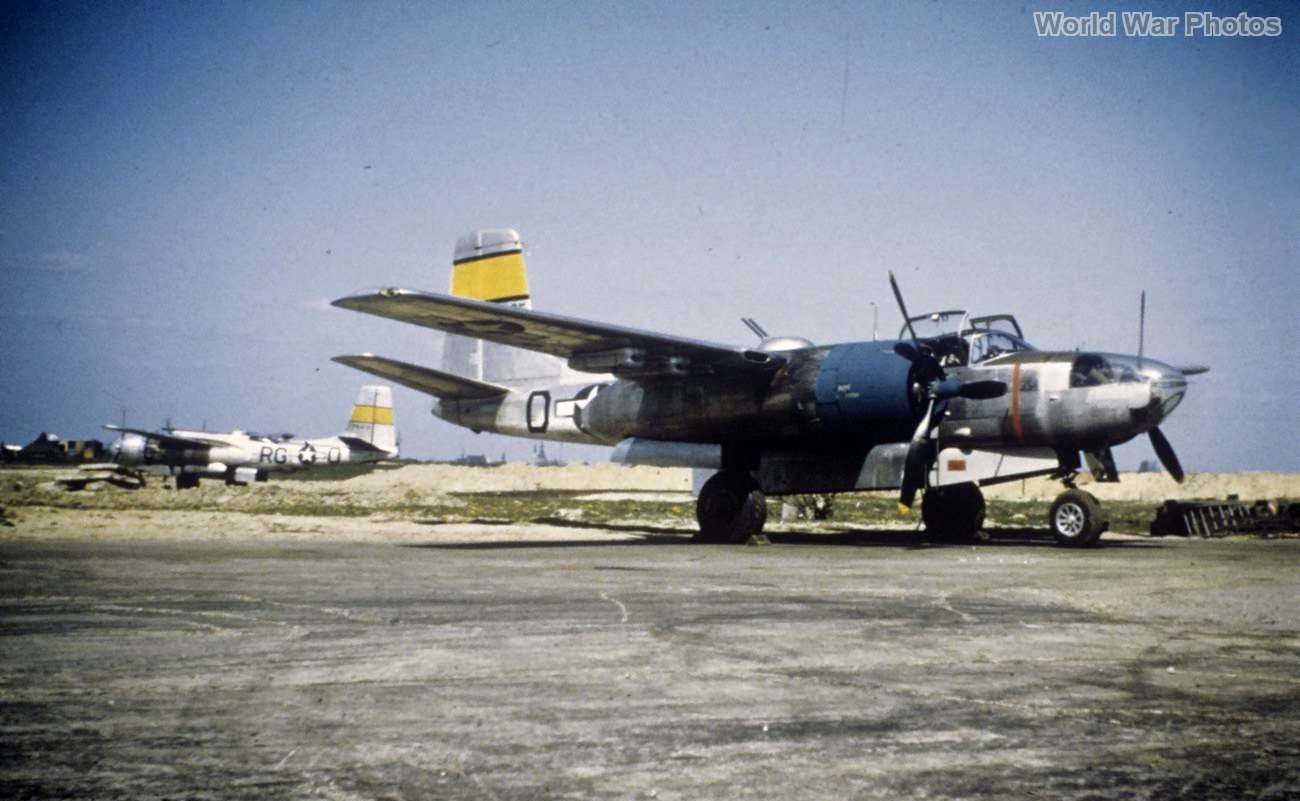The 386th Bombardment Group (386th BG) was a highly active unit in the European Theater during World War II, initially serving under the 8th Air Force before being transferred to the 9th Air Force in October 1943. The group was primarily equipped with B-26 Marauders and later transitioned to A-26 Invaders as the war progressed.
Operational History
Early Missions (1943):
- The 386th BG began operations in July 1943 while stationed at Great Dunmow in Essex. Initially, the group focused on attacking enemy airfields, with secondary targets including railway yards and defensive positions. The group played a vital role in disrupting the German Luftwaffe’s operational capabilities through these strikes.
Transition to the 9th Air Force:
- In October 1943, the 386th BG was transferred from the 8th Air Force to the 9th Air Force, aligning with the latter’s focus on tactical support of ground forces.
Winter Campaign (1944-1945):
- During the winter of 1944/45, the group was heavily involved in the campaign against V-1 flying bomb sites in the Pas de Calais region. This effort was crucial in mitigating the threat posed by these early cruise missiles.
- In the last week of February 1944, the group expanded its focus to include airfields in Holland and Belgium, targeting key installations to weaken German air support ahead of the Normandy invasion.
Normandy and D-Day:
- In the lead-up to D-Day, the 386th BG participated in the extensive bombing campaign aimed at “softening up” northern France. This included attacks on bridges over the Seine, railway depots, and airfields.
- On D-Day itself, the group concentrated on destroying coastal gun batteries, which were critical in ensuring the success of the amphibious landings.
Post-D-Day Operations:
- Following D-Day, the 386th BG maintained relentless pressure on strategic targets behind enemy lines, contributing to key operations such as the assault on German positions at St. Lo in July 1944.
- In August 1944, the group supported the Allied advance by targeting German forces in the Falaise pocket and later attacked strongholds in the port of Brest during September.
Transition to A-26 Invaders:
- The 553rd Bomb Squadron within the 386th BG was the first squadron in the European Theater of Operations (ETO) to convert to the new A-26 Invader aircraft in September 1944. By January 1945, the entire group had transitioned to the A-26, allowing for continued high-intensity operations deeper into German territory.
Battle of the Bulge:
- During the Battle of the Bulge in December 1944 and January 1945, the 386th BG played a crucial role in targeting bridges to disrupt German supply lines, a key factor in the eventual Allied victory.
Final Operations and Return to the USA:
- After the Ardennes campaign, the group continued its strategic bombing operations into Germany, including the noteworthy mission on 19 February 1945 where Major Myron L. Durkee was credited with the probable destruction of a German Me 262 jet fighter, showcasing the agility of the A-26 Invader.
- The group’s title was slightly altered to “Light” in June 1945, reflecting its role as a light bombardment group. Shortly afterward, the 386th BG began returning to the USA, where it was deactivated.
Unit Decorations
- Distinguished Unit Citation (DUC):
- European Theater of Operations (ETO): 30 July 1943 – 30 July 1944.
Commanders
- Col. Lester J. Maitland: Commanded from 1 December 1942.
- Col. Richard C. Sanders: Took over on 18 November 1943.
- Col. Joe W. Kelly: Commanded from 22 January 1944.
- Col. Thomas G. Corbin: Took command on 25 August 1944.
Stations
- England:
- Snetterton Heath, Norfolk: 3 June 1943.
- Boxted, Essex: 10 June 1943.
- Great Dunmow, Essex: 24 September 1943.
- France:
- Beaumont-sur-Oise, Picardie: 2 October 1944.
- Belgium:
- St. Trond, Province Limburg: 9 April 1945 – 27 July 1945.
Squadrons and Codes
- 552nd Bomb Squadron (BS): RG
- 553rd Bomb Squadron (BS): AN
- 554th Bomb Squadron (BS): RU
- 555th Bomb Squadron (BS): YA
Aircraft
- B-26 Marauder: Initially used by the group from 1943 until early 1945.
- A-26 Invader: Introduced in the 553rd BS in September 1944, with full group conversion by January 1945.
Aircraft Markings
- Group Marking:
- The 386th BG utilized a distinctive yellow horizontal stripe, approximately 30 inches high, across the fin and rudder of their aircraft. This stripe was accented with 3-4 inch black stripes at the top and bottom on natural metal finishes.
- Squadron Code and Call Letters:
- These were positioned on both sides of the fuselage, fore and aft of the national insignia. Initially, RAF or ANA 610 Sky colors were used on camouflaged surfaces, later replaced by black on natural metal finishes.
